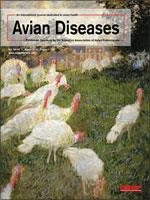Disease surveillance is vital to the management of New Zealand's endemic and threatened avian species. Three infectious agents that are potential threats to New Zealand's endemic birds include avian polyomavirus (APV), beak and feather disease virus (BFDV), and avian malaria. All three agents have been reported in New Zealand; however, possible reservoir populations have not been identified. In this communication, we report the first study of APV, BFDV, and avian malaria in introduced adult exhibition budgerigars (Melopsittacus undulatus) in New Zealand. Blood samples were collected from 90 living adult budgerigars from three breeding locations in the North Island of New Zealand. An overall APV prevalence of 22% was determined using a broad-spectrum nested PCR that amplified the major capsid protein VP1 gene of polyomavirus. Phylogenetic analysis of the VP1 gene revealed a unique isolate of APV, which had a sequence divergence of 32% to previously reported budgerigar fledgling disease strains and 33% to the recently reported New Zealand finch isolate. All of the budgerigars sampled were found to be PCR negative for BFDV, and an overall prevalence of 30% was detected by PCR for avian malaria. Sequencing revealed the presence of ubiquitous malarial strains and also the potentially destructive Plasmodium relictum strain. The results of this study suggest that both APV and avian malaria are present in New Zealand adult budgerigars, and our study highlights the need for further studies to determine whether these pathogens in captive bird populations may be a threat or spill over into New Zealand's endemic and threatened avifauna and whether prevention and control methods need to be implemented.
Un estudio de enfermedades de tres poblaciones reproductoras de periquitos australianos (Melopsittacus undulatus) de exhibición en Nueva Zelanda revela una alta prevalencia de una infección por un nuevo poliomavirus y por la malaria aviar.
La vigilancia de enfermedades es vital para el manejo de las especies aviares endémicas y amenazadas de Nueva Zelanda. Tres agentes infecciosos que son amenazas potenciales para las aves endémicas de Nueva Zelanda incluyen al poliomavirus aviar (APV), el virus de la enfermedad del pico y plumas (BFDV), y la malaria aviar. Los tres agentes se han reportado en Nueva Zelanda, sin embargo, no han sido identificadas poblaciones de posibles reservorios. En este artículo se presenta el primer estudio de poliomavirus aviar, del virus del pico y las plumas y de la malaria aviar en periquitos australianos (Melopsittacus undulatus) adultos de exhibición introducidos a Nueva Zelanda. Se recolectaron muestras de sangre de 90 periquitos adultos vivos de tres lugares de cría en la Isla Norte de Nueva Zelanda. Se determinó una prevalencia general de poliomavirus aviar de 22% utilizando un método de PCR anidado que amplifica el gene de la proteína principal de la cápside VP1 del poliomavirus. El análisis filogenético del gene VP1 reveló un aislamiento único de poliomavirus, que tenía una divergencia de 32% en su secuencia en comparación con las cepas previamente asociadas con la enfermedad de la muda francesa de los periquitos (budgerigar fledgling disease) y de un 33% con un aislamiento de pinzón de Nueva Zelanda reportado recientemente. Todos los periquitos muestreados resultaron ser negativos por PCR para la enfermedad del pico y las plumas, y se detectó una prevalencia general del 30% por PCR para la malaria aviar. La secuenciación reveló la presencia de cepas de malaria ubicuas y de una cepa de Plasmodium relictum que es potencialmente destructiva. Los resultados de este estudio sugieren que tanto poliomavirus aviar y la malaria aviar están presentes en periquitos australianos adultos de Nueva Zelanda y ponen de manifiesto la necesidad de realizar más estudios para determinar si estos patógenos presentes en poblaciones de





